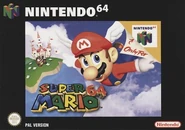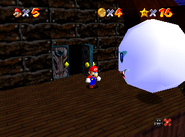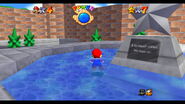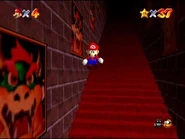| "Can everyone please stop telling jokes and start actually helping?!" | |
|---|---|

|
Wendy O. Koopa is not happy. She has spotted broken links on this article. You can make her proud by helping MarioWiki editors create pages! |
Template:Game infobox Super Mario 64 (スーパーマリオ64, Sūpā Mario Rokujūyon), commonly abbreviated as SM64, is the first three-dimensional platformer starring Mario, and was released on the Nintendo 64 in 1997 in Europe and 1996 elsewhere.
At the time, it received widespread critical acclaim, and has been often said to have defined its genre by being one of the first well-made games of its type. The game has since received a remake on the Nintendo DS in the form of Super Mario 64 DS. There was also going to be a sequel made, called Super Mario 128, but it was cancelled.
Story
Princess Toadstool sends Mario to come to her castle to have a cake. When Mario arrives, he meets the Lakitu Bros., whom are filming Mario. They go inside the castle and hear a familiar voice telling him to get out of the castle. Toad informs him that Bowser has kidnapped the princess again and is holding everyone hostage inside the castle walls.
He has also stolen the Power Stars and given them to his minions who are hiding in paintings spread all over the castle. Mario hops in the magical paintings and retrieves the Power Stars in order to defeat Bowser and save the Princess.
During the journey, Mario makes his way to more areas of the castle. When he finds out he has enough stars, he goes into Bowser's final level. Once he makes his way through the long course, Mario sees Bowser, and the two battle. When Mario defeats Bowser, he gives up and hands him a Giant Power Star, before he explodes. Mario grabs the star, and has been given the Wing Cap and flies away back to the castle.
As Mario's Wing Cap disappears, he uses the Giant Power Star to make Princess Peach appear. Peach wakes up and thanks Mario, by giving him a kiss, and the cake she had promised before.
Gameplay
The aim of the game is to collect enough Power Stars to progress to new, previously inaccessible areas of the castle. The primary goal is to collect enough to reach the final battle and save Princess Peach from Bowser. Each level, or "course", holds six stars, plus one for collecting one hundred coins, which are obtained by completing a certain mission. The only clue to what this may be is in the star's title, which is often cryptic. Aspects of each course vary with each star; beyond this, the player is given free reign in exploring each world.
Super Mario 64 introduced a number of abilities to the series, allowing Mario to crawl, Ground Pound, punch and kick, backflip, sideflip, wall-kick, long-jump and slide, amongst others. These moves give the player a greater freedom than in past games as regards ways that Mario can be controlled, introducing the idea of there being a number of alternative routes to arrive at any one place. These are additionally used to perform actions such as pressing down switches as well as harming enemies or reaching high or distant places. The game's use of the Nintendo 64 controller's Analog stick is another first for the Mario series, and allows the player to move Mario at different speeds by controlling the stick. This allows Mario to walk slowly, which, as opposed to running, does not awaken sleeping enemies.
Caps are another aspect introduced to the gameplay in Super Mario 64, giving Mario the ability to fly, walk underwater or walk through certain barriers. They are turned on in short bursts, and made available when activated with the switch associated with each one.
Characters
Main Characters
Supporting
- Lakitu Bros.
- Bob-omb Buddies
- Koopa the Quick
- Hoot the Owl
- Mother Penguin
- Tuxie
- Big Penguin
- Headless Snowman
- MIPS
- Dorrie
- Yoshi
Enemies
New
- Amps
- Bomps
- Bookends
- Bullies
- Chuckyas
- Fire Spitters
- Fwoosh
- Grindels
- Heave-Hos
- Killer Chairs
- Klepto
- Kuromames
- Mad Pianos
- Moneybags
- Mr. Blizzards
- Mr. Is
- Scuttlebugs
- Skeeters
- Snufits
- Spindel
- Spindrifts
- Sushis
- Tox Boxes
- Tweesters
- Unagis
- Whomps
Returning
- Banzai Bills
- Banzai Bill Blaster
- Beach Koopas
- Big Steelies
- Bob-ombs
- Boos
- Chain Chomp
- Cheep Cheeps
- Fire Piranha Plants
- Grand Goombas
- Goombas
- Koopa Troopas
- Lakitus
- Lava Bubbles
- Micro Goombas
- Monty Moles
- Piranha Plants
- Pokeys
- Spinies
- Swoopss
- Thwomps
- Ukikis
Mini-Bosses
Bosses
Courses
Main courses
- Bob-omb Battlefield
- Whomp's Fortress
- Jolly Roger Bay
- Cool Cool Mountain
- Big Boo's Haunt
- Hazy Maze Cave
- Lethal Lava Land
- Shifting Sand Land
- Dire Dire Docks
- Snowman's Land
- Wet Dry World
- Tall Tall Mountain
- Tiny Huge Island
- Tick Tock Clock
- Rainbow Ride
Power-ups
- Wing Cap
- Metal Cap
- Vanish Cap
- Koopa Shell
- One-up
Items
Attention MarioWiki users!: This section is short or lacks sufficient information. Whether you are commenting or editing, we would appreciate it if you help MarioWiki by expanding it.
Regional Differences
There are some regional differences between the U.S, Japan,PAL, and the Shindou releases of Super Mario 64.
List of Differences between U.S, and Japanese Versions:
- In the U.S version when you start the game, Mario says "Hello!" to the player on the screen. The Japanese version does not have this.
- In the U.S version when you select a file in the file select screen, Mario says "Okie Dokie" to the player. In the Japanese release, it does not have this.
- Mario says "let's-a-go" when you select a star in the course selection in the U.S version.
- When the letter from Princess Peach is shown in the intro, Peach speaks on what she wrote. Again the Japanese version doesn't have the voice acting.
- In the Game Over screen when Mario appears, he says "Game-over!". This once again is not said in the Japanese release.
- The Chain-Chomp sounds a lot different in the Japanese version than the U.S version.
- The red coins' sound has a higher pitch when you collect it in the U.S release. The Japanese release has a high-pitched coin sound but it remains when you collect more red coins.
- In the Japanese version, in the Jolly Roger bay level one star can be collected by jumping off the needle and then grabbing it. But in the U.S version, you have to open a box in order to get it.
- In one mission for Cool, Cool Mountain you have to bring the penguin back to its mom. But for some reason, the star is placed in a different position.
- After collecting a key in one Bowser mission, the key floats above Mario's head when you get it. The Japanese version doesn't have this.
- In the JP version, there was an error in the code, if Mario gets 1,000 coins, Mario's lives is -25, if Mario dies, Mario's lives is -25, spite the counter does not reset when returning to the castle, if Mario enters a level, it resets to 0. However, if Mario gets 32,768 coins, it is no longer true that coins>999, so the game is no longer constantly setting Mario's lives to -25. However, if Mario dies when the counter is 0, Mario's lives go from -25 to -26, if it was -128, it will go down from -128 to 100, not 127.
- Error shown in red. V
- GCode: if (lives>100) then lives=100; if (coins>999) then lives=999
- ICode: if (lives>100) then lives=100; if (coins>999) then coins=999
PAL Version Differences:
- In the PAL version the game runs at only 25 frames per second while the U.S and Japanese have 30 frames per second.
- In the PAL version, for some reason, when you enter a Bowser door, the sound is different.
- The painting for the Jolly-Roger bay course is different in the U.S and PAL version as it shows a ship rather than bubbles which are shown in the Japanese version of the game.
Shindou Version Release:
- When you release Bowser after spinning him, Mario only says "Bye-Bye!" rather than "So long King Bowser!" or "Here we go!". This is because Bowser's Japanese name is ''Koopa''.
- When you grab on a tree and release out of it, you actually spin a lot longer than in any other version of the game.
Gallery
Ratings
- GameRankings gave the game a high score of 95.9%/100%.
Trivia
- Contrary to popular belief, this game was technically NOT Charles Martinet's debut as Mario's voice actor - this instead happened in Mario's FUNdamentals. However, it is the first mainstream Mario game he voiced, and thus, is regarded as his effective debut in the role.
- Though false, the Gamers edition of the Guinness Book of World Records 2011 states that Super Mario Bros. was ported to the Nintendo 64, vaguely referencing Super Mario 64 being one of its sequels.
- This is the first Mario game to feature a method of invincibility other than a Starman.
- Although the Starman's music was retained for certain bonus stages, as well as when Mario possesses the Wing and Vanish Caps, or surfs on a Koopa Shell.
- This was the first Mario platformer to not feature Super Mushrooms and the first since Super Mario Bros. 2 to not feature Fire Flowers.
- Wrinkly can sometimes be seen playing Super Mario 64 in her Save Cave in the Super Nintendo Entertainment System version of Donkey Kong Country 3: Dixie Kong's Double Trouble!, due to the "Behind the Castle Walls" music explaining it all.
- Super Mario 128 was supposed to be its sequel, but it got some tweaks and is now Pikmin, which technically makes Pikmin Super Mario 64's "sequel".
- Pressing the A button on the "Press Start" screen that has Mario's face on it will cause a hand to appear, allowing the player to stretch Mario's ears, nose, cheeks, mouth, and the top of his head.
- Holding the R button will lock Mario's face in the stretched position.
- Boo's laugh is a high-pitched version of Bowser's laugh, most likely to save space.
- Tiny-Huge Island is a reference to Giant Land from Super Mario Bros. 3.
- The song titled Bowser's Road from this game was remixed at certain parts in Super Smash Bros. Melee. This was later remixed for Super Mario Galaxy.
- Interestingly, when using both the Wing and Metal Cap at the same time, an unused texture of a metal wing for the Wing Cap will appear. But this is impossible in-game, as both power-ups are not featured in the same course.
- There is a glitch know to speedrunners of Super Mario 64 as the "BLJ" or Backwards Long-jump, which when preformed, causes the player to gain incredible speed. This is used to skip many parts of the game.
- This is one of the two 3D Mario games to not feature Luigi, the other being Super Mario Sunshine.
- Despite this, there have been many rumors of Luigi being playable in the game. It was said that a player would have to run around the fountain 2401 times to unlock him, as fans believed that the translation on the fountain in the castle courtyard said "L is real 2401", though these rumors was later proven false. This is very similar to when Waluigi was rumored to appear in the DS remake.
- More interestingly, is that Luigi was initially discussed for the game during the development period, but never went beyond discussion as the game was already proving to be quite a test on the N64's hardware just with Mario alone, so Luigi was cut.
- Despite this, there have been many rumors of Luigi being playable in the game. It was said that a player would have to run around the fountain 2401 times to unlock him, as fans believed that the translation on the fountain in the castle courtyard said "L is real 2401", though these rumors was later proven false. This is very similar to when Waluigi was rumored to appear in the DS remake.

| ||
|---|---|---|
| Dr. Mario 64 (2001) • Mario Golf (1999) • Mario Kart 64 (1996) • Mario Party (1998) • Mario Party 2 (1999) • Mario Party 3 (2000) • Mario Tennis (2000) • Paper Mario (2000) • Super Mario 64 (1996) • Super Smash Bros. (1999) • Yoshi's Story (1997) | ||











